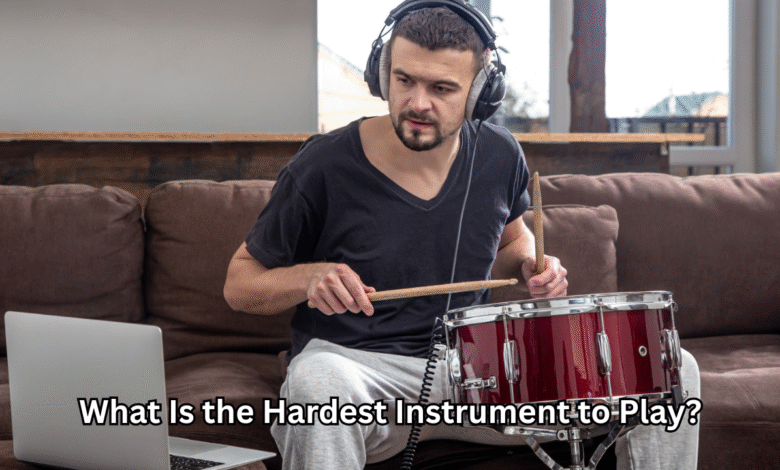What Is the Hardest Instrument to Play? The Ultimate Guide to the Most Challenging Musical Masterpieces

Introduction to Musical Mastery
What Is the Hardest Instrument to Play? – Music has always been a universal language, but learning to speak it fluently through an instrument can be a lifelong challenge. While every instrument requires dedication and skill, some are notoriously difficult to master. The question, “What is the hardest instrument to play?” often sparks debate among musicians and enthusiasts alike. The answer depends on a combination of physical coordination, technical precision, and emotional expression. In this article, we’ll explore the instruments that are considered the most difficult to play, what makes them so challenging, and what it takes to become proficient.
Defining “Hardest” in the World of Music
Before identifying which instrument is the hardest to play, it’s important to understand what makes an instrument difficult. Difficulty can depend on several factors, such as:
- Physical demand: Some instruments require exceptional breath control or fine motor skills.
- Technical complexity: Instruments with complicated fingerings or tuning systems can take years to master.
- Coordination: Playing while reading music, controlling rhythm, and adjusting dynamics simultaneously is not easy.
- Emotional expression: The ability to convey emotion through an instrument separates beginners from true artists.
With these factors in mind, let’s look at some of the most challenging Instruments that demand immense patience, skill, and discipline.

The Violin – Precision and Passion Combined
The Violin often tops the list of the hardest instruments to play, and for good reason. There are no frets to guide finger placement, so players must rely entirely on their ear and muscle memory to produce the correct pitch. Bow control adds another layer of complexity—pressure, speed, and angle must be perfectly balanced to achieve a clean tone.
Beyond the technical demands, violinists must also master vibrato, shifting, and dynamics, all while maintaining perfect posture. It can take years of daily practice to produce a sound that’s both accurate and beautiful.
The French Horn – A Challenge of Breath and Accuracy
The French horn is widely regarded as one of the most difficult brass instruments. Its tubing is long and tightly coiled, which makes hitting the right notes incredibly precise. A tiny change in lip tension can result in a completely different pitch.
Additionally, the French horn demands exceptional lung capacity and control. Musicians must also use their right hand inside the bell to adjust tone and intonation, adding another level of coordination. Even professional horn players admit that it takes years to develop consistency and confidence.
The Oboe – Mastering Breath Control and Reed Resistance
The oboe may look simple, but it is one of the most demanding woodwind instruments. Its double reed requires players to use precise breath pressure to produce a stable sound. Too much air, and the tone becomes harsh; too little, and the sound cuts off entirely.
Another challenge is the oboe’s tuning stability—it is extremely sensitive to humidity, temperature, and even slight changes in embouchure. On top of that, oboists often make their own reeds, which requires craftsmanship and patience. This makes the oboe both a musical and mechanical challenge.
The Organ – Coordination on a Grand Scale
The organ stands out as a masterpiece of coordination. Unlike most instruments, it requires the player to use both hands and both feet simultaneously. Each hand controls a different keyboard, while the feet play a separate set of pedals that produce bass notes.
Organists must also manage the stops and levers to control the tone and volume. Learning to read and perform complex organ scores is mentally demanding, as it feels like playing three instruments at once. The coordination, reading ability, and timing required make it one of the hardest instruments to master.
The Harp – Grace, Complexity, and Dexterity
The harp combines elegance with technical difficulty. With dozens of strings and seven pedals to control pitch, harpists must manage an intricate system of coordination. Unlike guitars or violins, each string on a harp corresponds to a single note, and changing keys requires rapid pedal adjustments.
The challenge lies in keeping track of all these elements while maintaining a smooth, flowing sound. The harp’s size and delicate touch also make it physically demanding, as it requires both strength and finesse.
The Piano – Simplicity on the Surface, Complexity Beneath
While many people start their musical journey with a piano, mastering it is no small feat. Pianists must read two clefs at once, use both hands independently, and control dynamics through touch and pedal use.
The piano’s versatility means it can handle melody, harmony, and rhythm simultaneously. This also means players must develop a deep understanding of music theory and exceptional coordination. Achieving expressive phrasing and perfect timing takes years of dedicated study.

The Bagpipes – Breath, Pressure, and Endurance
The bagpipes are another instrument that test a player’s physical and technical limits. Maintaining constant air pressure in the bag while playing melodies with the fingers requires intense multitasking. The coordination needed to keep a steady drone while performing intricate finger movements is remarkable.
Additionally, learning to tune and maintain the reeds can be frustrating. Bagpipes demand endurance and stamina, making them one of the hardest wind instruments to master.
The Cello – Emotion and Technical Mastery
The cello shares many challenges with the violin but adds the complexity of larger finger spacing and a heavier bow. Cellists must use the full range of the instrument—from deep bass to soaring high notes—while maintaining perfect intonation and expressive control.
The emotional range of the cello is vast, and players must learn how to channel emotion into each performance. The combination of technical skill and expressive depth makes the cello both demanding and rewarding.
Instruments That Are Difficult for Beginners but Rewarding Over Time
Some instruments, like the flute, clarinet, or guitar, are accessible to beginners but require years of refinement to master. These instruments challenge players to improve their tone, technique, and musicality continuously.
While they may not be as technically demanding as the violin or oboe from the start, achieving professional-level skill is equally challenging. Mastery in music always comes down to practice, patience, and passion.

What Truly Makes an Instrument “Hardest”?
Ultimately, the hardest instrument to play depends on the individual. Factors such as physical ability, musical background, and personal interest play huge roles. For instance, someone with excellent finger dexterity might find the piano easier than the trumpet, while another person may struggle with string instruments but excel in percussion.
The key is consistency and love for the craft. Every musician, no matter the instrument, faces challenges unique to their art. The true difficulty lies not in the instrument itself, but in the journey toward mastery.
Conclusion: The Hardest Instrument Is the One You Commit To
So, what is the hardest instrument to play? The answer isn’t a single instrument—it’s the one that challenges you the most. Whether it’s the precise fingerwork of the violin, the breath control of the oboe, or the multitasking of the organ, every instrument demands dedication and heart.
Becoming a great musician takes patience, perseverance, and passion. No matter what instrument you choose, the reward of creating music that moves others makes the struggle worthwhile. The hardest instrument to play, in truth, is the one you haven’t yet mastered—but every note you play brings you closer.
Also Read: Martin Lawrence Net Worth – Career, Biography, Income Sources & Lifestyle




One Comment